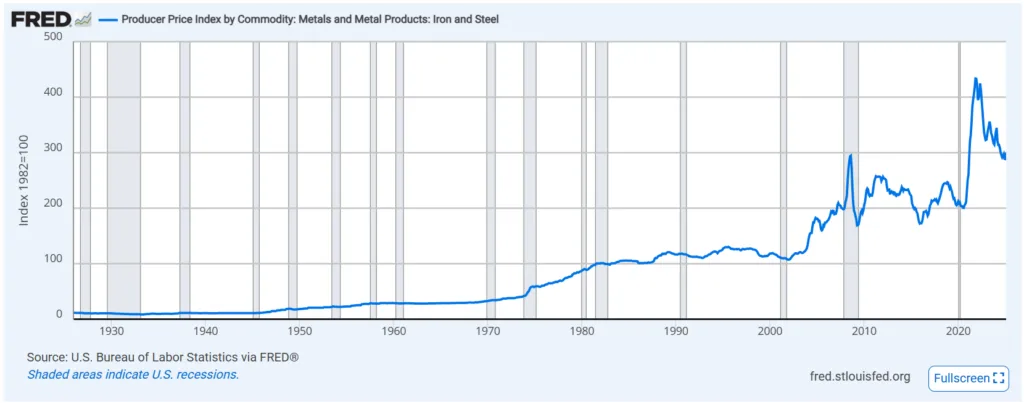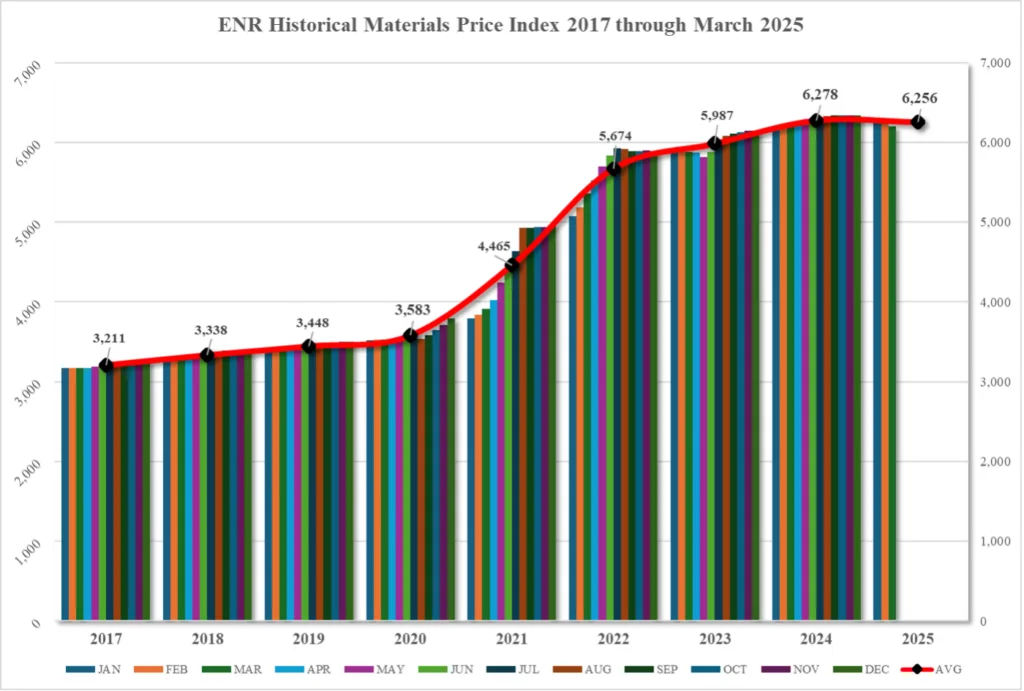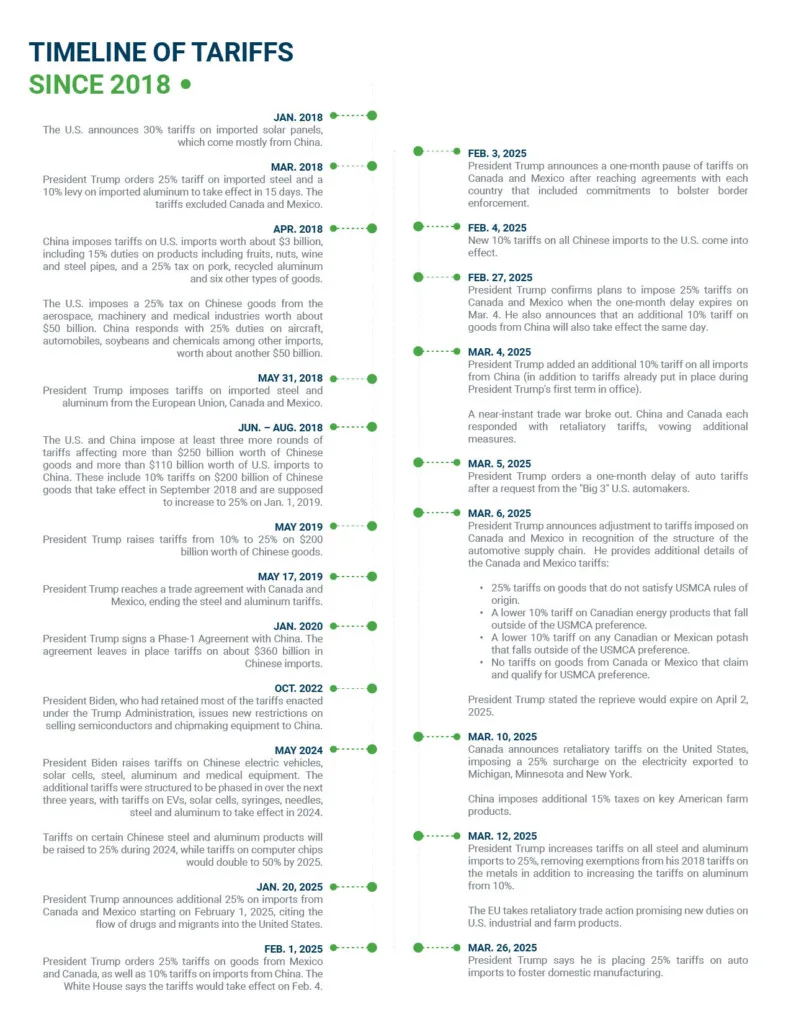Executive Summary
Recent announcements by the U.S. on tariffs for steel, aluminum, and other imported goods from Mexico, Canada, and China will have implications for the construction industry. With a 25 percent increase on steel and aluminum imports and an additional 20 percent tariff on Chinese products, construction companies reliant on these goods face escalating material costs and supply shortages that lead to project delays. Historical examples, such as the tariffs levied in 2018, show that rising construction execution costs and reduced output in manufacturing stem from these policy decisions. Industry participants must anticipate challenges in the near-term and adopt tactics to ensure project continuity.
- What do you do when your material costs increase by 10%?
- How do you pivot when shortages threaten to cause significant delays to your project?
- How much will tariffs raise the cost of your steel or lumber purchases this year?
April 2, 2025 – by Delta Consulting Group – On March 12, 2025, President Trump announced that the U.S. will impose a 25 percent tariff on steel and aluminum imports and other goods from Mexico and Canada, plus an additional 20 percent tariff on all Chinese products. With no alternative source in the near-term, tariffs on steel and aluminum will escalate costs, increase delivery time and cause shortages in key materials.
The construction industry is highly reliant on imports to execute projects in the U.S. According to the Aluminum Association, an industry advocacy group, the U.S. sources two-thirds of the primary aluminum it uses every year from Canada. Their data shows that approximately 90 percent of scrap metal used in the U.S. is from either Canada or Mexico, adding that U.S.-based smelters, even at full capacity, “cannot produce nearly enough metal to meet demand.”[1]
Reciprocal tariffs on U.S. imports add further complexity and uncertainty for the construction industry. China, Canada and the EU have announced tariffs on exported goods and materials to the U.S., with the timing and extent of those tariffs still unfolding. Notably, the Government of Canada recently released details on a Tariff Relief Program that is intended to help businesses and workers directly impacted by tariffs on products from the U.S. This relief includes favorably priced direct loans to businesses, trade commissioner services that help companies diversify their operations, and a remission process to address situations where goods cannot be sourced domestically or from non-U.S. sources.[2][3]
Current data shows that broad uncertainty is resulting in increased material costs. Steel prices have surged in the first quarter of 2025, with hot rolled coil prices in the Midwest jumping by 20 percent between January 20, 2025, and mid-February, according to data provider Fastmarkets.[4] For comparison, the price of the same type of steel has risen six percent in northern Europe over the same period.
Consistent with this finding, an analysis by John Burns Research & Consulting estimates tariffs may drive up average building material costs, in general, by 10 percent, nearly two and a half times the increase anticipated under normal market conditions.[5]
The impact of cost increases is direct, but there are downstream impacts, as well. Manufacturers of steel and aluminum products will need to raise prices or absorb the additional cost. These effects will dampen a company’s ability to reinvest in business assets. And, according to William Oplinger, CEO of Alcoa, the aluminum tariffs could cost 100,000 American jobs.[6]
Then, consider the impact of delays. A significant event, such a widespread steel shortage, can cause an average project delay of 20 to 30 percent.[7]
While U.S. tariffs could make domestically produced goods more cost competitive, replacing higher priced international goods will require investment in manufacturing, and it will be years before the benefit will be realized.
While rising construction execution costs and reduced output in manufacturing are creating concern and uncertainty, construction companies can look to historical precedent to anticipate potential challenges and adopt tactics to ensure project continuity.
What We Can Learn from The Past
Tariffs are not new. Early in the nation’s history, tariffs were used primarily to generate revenue. The Tariff Act of 1789, signed by President George Washington, imposed a tariff of 5 percent on imports. The reliance on tariffs continued, along with a steady increase in the import duty. The high tariffs in the nation’s early history generated revenue and promoted the industrialization of the U.S.[8]
After World War II, in a move toward globalization, the General Agreement on Tariffs and Trade (GATT) was formed to facilitate reciprocal and mutually advantageous arrangements for the substantial reduction of tariffs and other barriers to trade, and to the elimination of discriminatory treatment in international commerce.[9] More than 20 countries signed the GATT, including the U.S., Canada, Great Britain, China and India.
Between 1948 and 1995 (when the World Trade Organization (WTO) replaced the agreement), the GATT presided over some of the highest trade growth periods in recent history. GDP per capita grew by nearly two percent annually. Merchandise trade grew by six percent annually for an 18-fold increase, and the share of world GDP represented by merchandise trade grew by nearly 150 percent. Opponents of the GATT and WTO argue, though, that this boon to the global economy came at the expense of jobs in developed countries, while leading to wage depression and challenges related to intellectual property rights.[10]
In 1959, the U.S. became a net importer of steel, which would shape much of the eventual policy on trade and tariffs. Then, in the early 1970s, the global steel market faced a prolonged downturn, which was exacerbated during periods of recession, and the federal government took a range of steps to try to protect the steel industry, including import quotas, trigger pricing, and voluntary export restraints. These tactics ultimately increased material costs for steel-dependent industries.[11]
In an example of a reversal of previous tariff activity, the signing of 1994’s North American Free Trade Agreement (NAFTA) gradually eliminated most tariffs and other trade barriers on products and services between the U.S., Canada and Mexico. NAFTA led to lower prices for some goods, including steel, due to increased competition and reduced tariffs.[12] In 2002, President George W. Bush levied tariffs on imported steel to offer some protection to U.S. steelmakers, but Canada and Mexico were exempted since provisions in NAFTA would impose high penalties on the U.S. for such actions.
Despite all of the apparent turmoil, prices remained relatively steady until the turn of the century.

Figure 1 – Producer Price Index by Commodity: Metals and Metal Products: Iron and Steel, Source: fred.stlouisfed.org
In early 2008, U.S. steel prices reached all-time highs, driven by booming demand from China. Companies like United States Steel Corp. and Nucor Corp. posted record results. A March 2008 report by the Associated General Contractors of America (AGC) noted that, “Red-hot steel prices, combined with record diesel fuel costs, are making construction unaffordable.” AGC’s Chief Economist Ken Simonson said at the time that the industry needed to adjust to the reality that construction costs were rising faster than the consumer price index (CPI).[13] However, just as construction companies were making adjustments to account for high material costs, the stock market crashed, and the U.S. faced the start of the Great Recession. New construction and automaking dropped off precipitously and shares of U.S. Steel dropped by 69% in the fall of that same year, outpacing the poor performance of the broader market by significant margins.[14]
The most relevant examples of the impacts of tariffs on the construction industry, are the 2018 tariffs on steel and aluminum imported from Canada and Mexico during negotiation of the US-Canada-Mexico Agreement (USMCA), ratified by all three countries on March 13, 2020. Here, the Trump Administration imposed similar tariffs on steel and aluminum imported from Canada and Mexico in 2018. As can be seen in the chart below, the average material price (tracking the weighted price movement across 20-city national indices of structural steel, portland cement and 2 X 4 lumber) significantly increases starting in mid-2020.

Figure 2 – Material Price Indices 2017-2025, Source: ENR
A U.S. International Trade Commission Report published in 2023 found that these prior tariffs had significant impacts to downstream industries, like construction. Further, they led to an annual $3.4 billion decrease in production from 2018 to 2021 due to the price increases, a 0.6 percent reduction per year on average. As of 2024, the construction and the auto industries were poised to be the most affected by any potential new steel tariffs.[15]
The Cost of Time
An increase in material costs is not the only concern related to global trade policy. Delays resulting from increased demand, decreased production or shortages related to tariff activity can also significantly impact the construction industry’s profitability.
In the early 1960s, a group of the nation’s leading steel companies reached a decision to raise the price of their product in the aftermath of the Steel Strike of 1959, a 116-day labor strike that shut down more than 85 percent of domestic steel production. The shortage forced American industries to import more steel from foreign sources to meet demand, but still resulted in delays or stoppage to several Bureau of Reclamation and other Federal Civil projects. A survey conducted by the Bureau of Public Roads indicated 84 interstate projects were either stopped or postponed due to the nationwide steel shortage.[16][17]
The steel shortage also impacted defense projects, according to an affidavit by Secretary Gates (Acting Secretary of Defense) in 1959. He informed President Eisenhower that delays to several missile programs, including launch sites and naval projects, were the result of the lack of special alloy steels not being produced during the strike.
In an article by Time magazine in the fall of 1959, Robert Tishman, executive vice president of Tishman Realty & Construction Co., commented on the impact of the shortage to the construction industry, “[w]ith very few exceptions, all construction jobs in the initial stages, where steel is a big factor, have been stopped.”[18] The article estimated that it would take up to 90 days of normal domestic production before deliveries would increase. Consider the impact a three-month material delay would have on an average project. From increased labor costs to damages claims and lost productivity, shortages can wreak havoc on the successful and profitable completion of a construction project.
The construction industry has faced booms and busts in the face of shifting trade policy. From the imposition or elimination of tariffs to the downstream impacts of broader trade policy, there is a necessary focus on safeguarding the industry to be more resilient against fluctuating market conditions through effective contract management. For projects in the planning or bidding process, participants must perform a risk analysis on the project budget and schedule. For ongoing projects, material prices and availability must be monitored closely, and contractors should act on change. While much remains in flux, now is the time to anticipate cost and supply impacts.

REFERENCES
[1] https://www.aluminum.org/news/aluminum-association-calls-strong-regional-trade-enforcement-north-american-tariff-exemptions
[2] https://www.canada.ca/en/department-finance/programs/international-trade-finance-policy/canadas-response-us-tariffs.html
[3] https://www.canada.ca/en/department-finance/programs/international-trade-finance-policy/process-requesting-remission-tariffs-that-apply-on-certain-goods-us.html
[4] https://www.reuters.com/markets/commodities/us-manufacturers-see-higher-metal-prices-tariffs-near-2025-02-24
[5] https://www.nahb.org/advocacy/top-priorities/addressing-the-supply-chain-crisis/how-tariffs-impact-home-building
[6] https://www.investopedia.com/alcoa-s-ceo-says-trump-tariffs-could-wipe-out-100-000-u-s-jobs-11686292
[7] https://blog.alicetechnologies.com/how-to-calculate-the-true-cost-of-a-construction-delay
[8] “Biden Struggles to Push Trade Deals with Allies as Election Approaches”
[9] General Agreement on Tariffs and Trade (GATT 1947)
[10] https://www.wto.org/english/thewto_e/minist_e/min99_e/english/book_e/stak_e_6.htm
[11] https://www.nber.org/system/files/chapters/c5960/c5960.pdf
[12] https://www.brookings.edu/articles/nafta-renegotiation-separating-fact-from-fiction
[13] https://www.agc.org/news/2008/04/15/red-hot-steel-fuel-prices-send-construction-costs-soaring-agc-says
[14] https://www.nbcnews.com/id/wbna28449461
[15] https://www.spglobal.com/ratings/en/research/articles/250212-economic-research-announced-steel-and-aluminum-tariffs-would-mean-little-change-for-u-s-gdp-and-prices-bigg-13413112#[16] https://www.proquest.com/docview/302643006/citation/A79DC06CA66D42FBPQ/1?accountid=15101&sourcetype=Dissertations%20&%20Theses
[17] The Steel Strike of 1959: Labor, Management, and Government Relations.
[18] https://time.com/archive/6802624/business-steel-the-strikes-blow/


